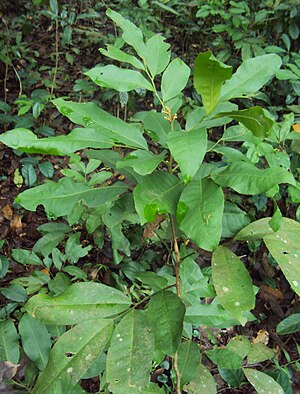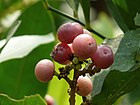Note: This is a project under development. The articles on this wiki are just being initiated and broadly incomplete. You can Help creating new pages.
Glycosmis pentaphylla
Glycosmis pentaphylla is an evergreen shrub or small tree growing up to 5 metres tall.The plant is harvested from the wild, mainly for local use as a food and medicine. It has gained in popularity as an edible fruit in parts of the Caribbean, where it is sometimes cultivated.
Uses
Bilious attacks, Diarrhoea, Coughs, Rheumatism, Anaemia, Jaundice, Fever, Liver complaints, Skin affections.[1]
Food
Glycosmis pentaphylla can be used in Food. Ripe fruits are eaten raw[2].
Parts Used
Chemical Composition
Common names
| Language | Common name |
|---|---|
| Kannada | ಗುರುವಾಡೆ Guruvade |
| Hindi | Ban nimbu |
| Malayalam | Kuttippanal |
| Tamil | Amutam |
| Telugu | Konda golugu |
| Marathi | Kirmira |
| Gujarathi | |
| Punjabi | Ban nimbu |
| Kashmiri | |
| Sanskrit | Ashvashakota |
| English | Gin berry, Opal orange |
Properties
Reference: Dravya - Substance, Rasa - Taste, Guna - Qualities, Veerya - Potency, Vipaka - Post-digesion effect, Karma - Pharmacological activity, Prabhava - Therepeutics.
Dravya
Rasa
Guna
Veerya
Vipaka
Karma
Prabhava
Nutritional components
Glycosmis pentaphylla Contains the Following nutritional components like - Vitamin-C; Carotenoid; Calcium, Iron, Magnesium, Manganese, Phosphorus, Potassium, Sodium[2].
Habit
Identification
Leaf
| Kind | Shape | Feature |
|---|---|---|
Flower
| Type | Size | Color and composition | Stamen | More information |
|---|---|---|---|---|
| {{{5}}} |
Fruit
| Type | Size | Mass | Appearance | Seeds | More information |
|---|---|---|---|---|---|
Other features
List of Ayurvedic medicine in which the herb is used
Where to get the saplings
Mode of Propagation
Cultivation Details
A plant of low to moderate elevations in the tropics. It should be hardy to at least 0°c[6]. Glycosmis pentaphylla is available through February-March[2].
Commonly seen growing in areas
Photo Gallery
References
- ↑ Indian Medicinal Plants by C.P.Khare
- ↑ 2.0 2.1 2.2 "Forest food for Northern region of Western Ghats" by Dr. Mandar N. Datar and Dr. Anuradha S. Upadhye, Page No.85, Published by Maharashtra Association for the Cultivation of Science (MACS) Agharkar Research Institute, Gopal Ganesh Agarkar Road, Pune
- ↑ [Chemistry]
- ↑ Common names
- ↑ [Morphology]
- ↑ Cultivation
External Links
- Ayurvedic Herbs known to be helpful to treat Bilious attacks
- Ayurvedic Herbs known to be helpful to treat Diarrhoea
- Ayurvedic Herbs known to be helpful to treat Coughs
- Ayurvedic Herbs known to be helpful to treat Rheumatism
- Ayurvedic Herbs known to be helpful to treat Anaemia
- Ayurvedic Herbs known to be helpful to treat Jaundice
- Ayurvedic Herbs known to be helpful to treat Fever
- Ayurvedic Herbs known to be helpful to treat Liver complaints
- Ayurvedic Herbs known to be helpful to treat Skin affections
- Herbs with Fruits used in medicine
- Herbs with common name in Kannada
- Herbs with common name in Hindi
- Herbs with common name in Malayalam
- Herbs with common name in Tamil
- Herbs with common name in Telugu
- Herbs with common name in Marathi
- Herbs with common name in Punjabi
- Herbs with common name in Sanskrit
- Herbs with common name in English
- Habit - Evergreen tree
- Index of Plants which can be propagated by Seed
- Index of Plants which can be propagated by Cuttings of half-ripe wood
- Herbs that are commonly seen in the region of Hillside
- Herbs that are commonly seen in the region of Valley woods
- Herbs that are commonly seen in the region of Secondary thickets
- Herbs
- Pages without herbs images




